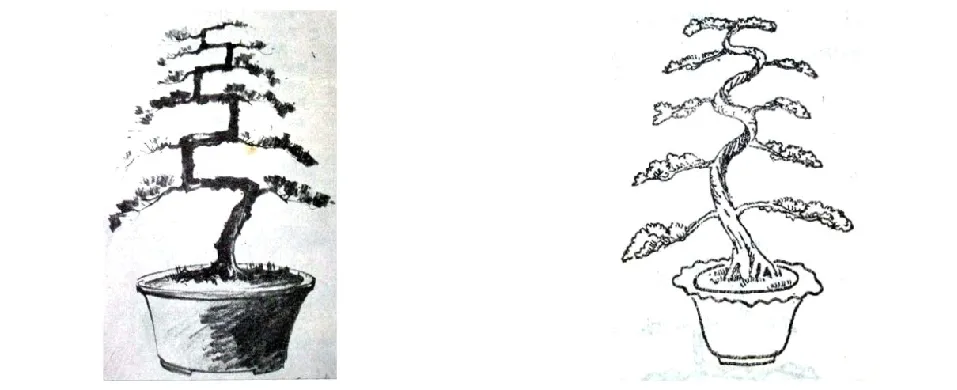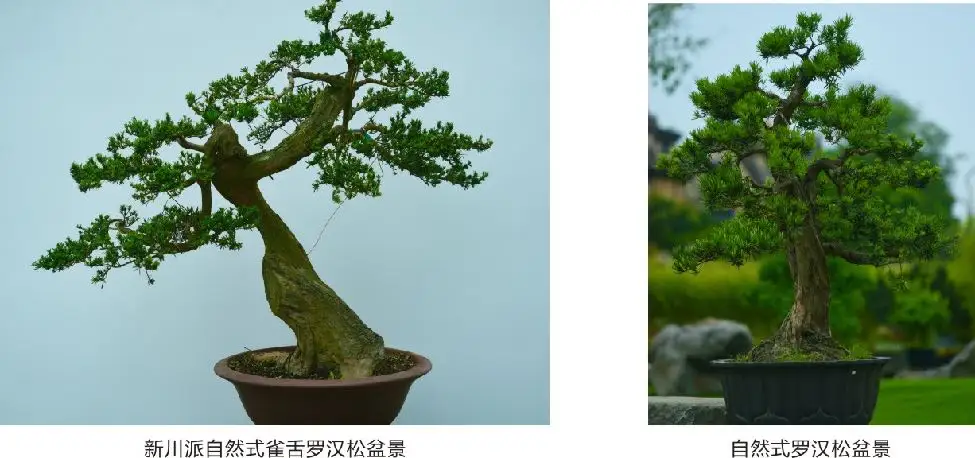Sichuan School Bonsai Art Museum (Wanjing Mountain House)
Sichuan School Bonsai Art Museum (Wanjing Mountain House)
Section I. History of Bonsai in China
Section 2: Categories of Bonsai in China
Section III: Styles and Schools of Chinese Bonsai
Section IV: Characteristics and production methods of Sichuan bonsai
Section V. Characteristics of Sichuan Bonsai Art
Section VI: The Garden of the Eight Hundred Lohan
Section VII. Potted landscape organizations and awards


Section I. History of Bonsai in China
1. Origins of the Han and Jin Dynasties
Our ancestors loved nature. As early as the Yin and Zhou Dynasties, more than 3,000 years ago, the cultivation of ornamental plants and the creation of gardens that mimicked mountain forests appeared. According to archaeological discoveries, there are potted flowers painted on the mural paintings of the tomb passages of the Eastern Han Dynasty (25-220) in Wangdu, Hebei, which can be regarded as the female form of bonsai.
After the Wei and Jin Dynasties (220-420 A.D.), advocating lightness, love of landscape, the pursuit of seclusion, a moment to form a trend. Landscape poetry, landscape painting rose one after another, bonsai also began to form.
2. Formation of the early Tang
The Tang Dynasty (618-907 A.D.) was a period of unprecedented prosperity in Chinese history, with brilliant achievements in a variety of cultures and arts. The mural painting of a maid's hand tray in the tomb of Prince Zhanghuai of the Tang Dynasty in Qianling, Shaanxi Province (built in 706) shows that bonsai had already been formed in China during the early Tang Dynasty. At that time, bonsai already used the configuration of rocks and trees, rich in natural flavor and landscape painting.
From the description of many Tang poems, it can be seen that the literati and scholars also took pleasure in making bonsai, and a variety of modeling forms appeared. Wang Wei, a poet and painter, used to "store orchids and crocuses in a yellow porcelain bucket and raise them in a stone". Poet Bai Juyi also has a poem describing the landscape bonsai. The Tang Dynasty painter Yan Liben's "Tribute Picture" depicts a hand holding a shallow basin of strange stones to pay tribute.
3. Development of the Song and Yuan
The unprecedented development of the art of painting during the Song Dynasty (960-1279) also contributed to the improvement of the art of bonsai. Whether it was the court or the folk, using bonsai as an ornamental has become a popular trend. From the Song painting "Eighteen Bachelors", "Ming Huang Peeping Bath", as well as Su Dongpo, Huang Tingjian, Lu You, Wang Shipeng and other poems, it can be seen that bonsai modeling has been more perfect. According to Japanese scholars, Chinese bonsai was introduced to Japan in the Southern Song Dynasty (late Heian Period in Japan).
In the Yuan Dynasty (1271-1368), advocating "some of the landscape", that is, a small landscape. Monk Susanna Shangren, traveling around, in and out of famous mountains and rivers, the production of bonsai to take nature, small in the big, full of pictures, the yuan after the production of bonsai standard of measurement has had a profound impact. From the pine and cypress bonsai "pine map" can be seen, modeling and modern has been very close.
4. The prevalence of the Ming and Qing Dynasties
During the Ming Dynasty (1368-1644 AD), Chinese bonsai began to enter a flourishing stage. From some literature and existing bonsai objects can be learned, at that time has formed a variety of artistic styles, technology is also more mature. Bonsai writings came out one after another. Tu Long of the Ming Dynasty wrote "Kao Nuan Yu thing - pots play denseness" in the bonsai standard: "bonsai to a few cases can be placed for the best, followed by a list of things in the garden also", and put forward to the ancients of the painters of the old trees as a comparison of the bonsai for the top grade.
Qing Dynasty (1616-1911 AD) bonsai has further developed. Bonsai materials were colorful, and the pots used were more elaborate. The bonsai paintings of Zheng Banqiao and Huang Shen, the Eight Monsters of Yangzhou, even more graphically demonstrated the art of bonsai at that time. Su Ling "Bonsai Occasional Record" in the bonsai plant is divided into four everyone, seven sages, eighteen bachelors and flowers and plants four elegant. It is clear that the development of bonsai was flourishing.
5. Modern revival
After the end of the Qing Dynasty, Chinese bonsai was in decline. At the end of the 1970s, a full revival began.
The first national bonsai art exhibition was held in Beijing in 1979, which became an important milestone in the development history of Chinese bonsai. Since then, bonsai associations have been set up all over the country, often organizing bonsai exhibitions and skill exchanges, promoting the popularization and improvement of bonsai. Many cities have established professional bonsai gardens and collection gardens for bonsai lovers. Chinese bonsai is also exported to many countries and regions.
The theoretical study of bonsai art began to be emphasized, and a variety of bonsai works were published. The teaching of bonsai skills gradually became diversified. The skill level of Chinese bonsai improved rapidly, and excellent works continued to emerge.
It is worth mentioning that although Taiwan has been separated from the mainland for decades, the art of bonsai is also very prevalent in Taiwan due to its common cultural origins.
Over the past thirty years, Chinese bonsai has participated in exhibitions held in more than ten countries in Europe, Asia and the United States as well as in Hong Kong and Macao, and Chinese bonsai practitioners have been invited many times to international bonsai conferences and demonstrations abroad. The International Bonsai Conference and Exhibition, Asia-Pacific Bonsai and Stone Appreciation Conference and Exhibition and other international conferences were successfully held in China. The direct spread of Chinese bonsai abroad has played a positive role in international cultural exchanges.
Section 2: Categories of Bonsai in China
1. Tree bonsai, with woody plants as the main material, through climbing, pruning, carving and other modeling processing and horticultural cultivation, in the pot to show the natural world tree landscape, known as tree bonsai. At present, China's bonsai tree species used in one, two hundred kinds of more, divided into pine and cypress, miscellaneous trees leaf wood, flowers and trees, fruit trees and vines.

2. Shanshui bonsai, natural rocks as the main material, after selection and processing, arranged in a shallow water basin, showing the natural landscape scene, known as Shanshui bonsai. Shanshui bonsai is divided into two categories: hard rock and soft rock.

3. Water and drought bonsai, water and drought bonsai is a combination of landscape bonsai and tree bonsai and a category. It takes plants, rocks, soil, water and other materials through processing, layout, in the pot to show the natural world of water, dry land, trees, rocks and both the landscape.

4. Miniature bonsai, miniature bonsai is defined by the volume of the bonsai. General tree height (tree bonsai) or pot length (landscape bonsai, water and drought bonsai) in 10 centimeters or less belongs to the miniature bonsai.

5. Wall-mounted bonsai, wall-mounted bonsai is a pot hanging vertically on the wall, or upright on the table, inside the inlaid rocks, planting plants, molded into a scene.
Section III: Styles and Schools of Chinese Bonsai
Yang faction (of populace)
The Yang School is a bonsai art school centered on Yangzhou and Qinzhou, including some surrounding areas. Tree bonsai takes pine, cypress, elm and boxwood as the main species, and adopts brown wire to tie and cut the branches and leaves into a "cloud-like" shape, and the branches are curved, with the fineness reaching "one inch and three bends". The works have distinct levels and are rich in decorative beauty. The water and drought bonsai and landscape bonsai are in various forms, and they are good at expressing poetic and picturesque feelings. In recent decades, the Yang School of Bonsai has made new development on the basis of inheriting the tradition.

Sichuan or Chuan school (16th century)
The Sichuan School is a bonsai art school centered in Chengdu, including the whole province of Sichuan and Chongqing, etc. The tree bonsai takes the Luohan Pine, Ginkgo, June Snow and Begonia as representative species. Tree bonsai to Luohan Pine, Ginkgo, Golden Bomb, June Snow, Sticky Begonia as the representative species, the use of brown wire tie cutting, tree trunk gnarled (qiu) curvature, branches and leaves in the shape of a "disk".
In recent decades, in addition to the traditional rules of bonsai, and the development of the natural style modeling, landscape bonsai and water and drought bonsai are "quiet, beautiful, dangerous, and male" is known.

Lingnan school (old term, esp. Guandong and Guangxi)
Lingnan School is a bonsai art school centered in Guangzhou, including the whole Lingnan area. Tree bonsai to bird's nest, hammer elm, nine lixiang, fujian tea, mountain pine as the representative species, the use of "storage branches cut off the trunk" pruning modeling method, strong, natural, elegant, bold; landscape bonsai to clear, dangerous and strange as the main features.
nautical school
The Hai School is a bonsai art school centered in Shanghai. It absorbs the advantages of domestic bonsai schools, and at the same time draws on overseas bonsai techniques, using wire climbing and pruning combination, forming a master of the natural, bright and smooth, pale ancient painting of the Hai School of bonsai. There are many kinds of trees, mainly pine and cypress, flowers and fruits.
Hai miniature bonsai exquisite and exquisite, landscape bonsai both male and female, unique.

Soviet Union faction (in the 1950s and 1960s)
Suzhou School is a bonsai art school centered on Suzhou and Changshu, including some surrounding areas. Tree bonsai, with hammer elm, bird plum, delta maple, plum blossom and pine and cypress as the representative species, specializing in ancient stakes styling, the use of brown wire "rough tie fine cutting", the tree branches and leaves into "cloud" shape, clean, elegant and ancient. With the development of the times, the material of Su School Bonsai has become more and more abundant, and the techniques are constantly being innovated.

Other styles
Zhejiang tree bonsai
Pines and cypresses as a group of representative species, using a combination of cutting and tying methods, natural people painting, shape and spirit.
Fujian Tree Bonsai
Ficus is the main tree species, focusing on cultivation, cutting and tying, natural and heavy.
Henan Tree Bonsai
With pomegranate, tamarisk and yellow wattle as the representative tree species, pale ancient, simple and clumsy, rigid and flexible.
Anhui Weizhou Tree Bonsai
Plum, cypress, Huangshan pine as the representative species, the use of "thick and thin cut", simple, peculiar.
Hubei tree bonsai to miscellaneous wood-based, diverse species, styling focus on dynamic potential, the spirit of the fly.
Jiangsu Nantong Tree Bonsai
To the bird's tongue Luo Han Pine as a representative species, using brown wire cutting and tying, the main trunk is made into "two bends and a half" ("S" shape), the branches and leaves for the piece, distinct levels.
bonsai
It is dominated by pine and cypress and some deciduous species, which are rigid, rough, majestic and ancient.
Bonsai in Taiwan, China
Both the characteristics of traditional Chinese culture and the influence of Japanese bonsai have been received, and its skillful and full-bodied modeling makes it unique in cypress carving.
Section IV: Characteristics and production methods of Sichuan bonsai
The Sichuan School of Bonsai is one of the four major schools of traditional Chinese bonsai, represented by Chengdu and Chongqing. Due to its long history, deep cultural heritage and long history of bonsai creation and development, the production skills are exquisite and have a strong local art style. And now it has also been declared as Intangible Cultural Heritage of Sichuan Province by Sichuan Bonsai Artists Association of Chengdu City, Sichuan Province.
Turning (Lohan Pine)

This modeling, can give a person the feeling of majestic, can be used in a variety of "branch type" coiled branch disk, but also can be added with the "band", changes in many ways. Usually the main trunk has five or six bends, used to coiled into five bends: one bend, two turns, three out, four back, five town top.
It is dominated by Luohan Pine, Juniperus communis, Huashan Pine, Metasequoia, Ginkgo, Pomegranate, Plum Blossom, Peach Blossom, Cherry Blossom, Osmanthus, Tea Blossom, and Rhododendron.
turn

It is also known as "positive body inflection", where the main trunk bends back and forth, usually only one main trunk, and the bends of the main trunk are back and forth. This kind of stump can be viewed from the front to see all the bends of the main trunk at the head of the stump, and gradually turn to the side, the bends gradually become smaller, and turn to the front side, the bends of the main trunk of the stump are not seen.
The Three Bends and Nine Turns (Begonia angustifolia)

Starting from the base of the trunk, the tree is coiled to the top in the shape of a pair of turns to count nine bends, sometimes in two or three times. Then, from the side of the backward bend, from the base of the trunk to the top, it is coiled into three big bends for the front side. The stump with three bends and nine bends is shaped in an ornamental way, and the landscape changes step by step from one side to the other, which is quite dynamic.
Lohan pine, sequoia, weeping begonias, yew, pomegranate, etc., with weeping begonias as the mainstay and yew as the second.
great bend drooping branch (botany)

Also known as the big bend hanging method. The trunk coiled into a big bend, coiled after the bend, the big bend on the top of the trunk and the whole bend on the branch all removed, sometimes also in the back side of the bend to leave a branch, coiled behind the foot of the disk and the foot of the disk of the upper branches of the disk, but this branch coiled to the downward drooping, must be able to coiled into three disks, four disks, at least can be coiled into three disks, or else, all cut, the use of the method of grafting by the new branches.
make a U-turn and drop the corner (idiom); fig. to take a turn

It is also known as the teasing method. Saw off the upper end of the trunk, leaving only the base (30-60cm), such as the issuance of strong new branches for coiling, selecting a strong branch coiled as the main trunk, coiled with the side branches for the forefoot disk.
be crowned with the title of straight horse

This method is mostly used for larger piles, the main trunk can not or should not be coiled, and the side branches are quite beautiful thick blanks, the top of the straight body branches, such as no suitable branches can be grafted on, the top of the branch only need to do two or three curves, with the side branches for the flat plate, this method of modeling is simple, quick results, only blanks are difficult to choose.
crutches

Also known as "Hanwen" abduction. The main stem bends back and forth, rather like a pair of abductions, except that the curved bends are coiled into a square shape with one side missing, similar to the "bow" form.
freezingzing of body weight

Abbreviated as the Rolling Dragon Method, also known as the Spiral Bend. The first and second bends are the same as the drop turn method, and the third bend spirals upwards.
Sichuan Bonsai is one of the four major schools of Chinese Bonsai, epitomizing the Bashan Shushui. YiYuan Bonsai is a representative image of Sichuan Bonsai window, to Sichuan precious trees, YiYuan "garden tree" - Luohan Pine is the main, with "China's first garden of Luohan" said.
Because of its nearly 1,000 ancient stakes of famous trees and strange boulders have been combined into a scene of ups and downs and mountains, so it is called "Wanjing Mountain Room". In addition to the inheritance of the basic elements of the traditional Sichuan bonsai features, one is the material, the second is the body method (style), the third is the process, and on this basis, and carry forward the characteristics of the above; and it is mainly embodied in the following characteristics:
-
Material Characteristics:In addition to gathering a large number of Sichuan's unique bonsai and materials such as Luohan Pine, ancient ginkgo stumps, Golden Bomb, Sticky Begonia, Ziwei, etc., the Sichuan Bonsai Art Museum also excavates, develops, and cultivates a large number of natural bonsai materials formed naturally in the high mountains for thousands of years, which are unique to the southwest region. We have introduced the world's rare bonsai materials "Taiwan True Cypress" and China Nantong bird's tongue Luohan Pine and Japanese Black Pine, Five Needle Pine, Luohan Pine.
-
Stance Characteristics:On the basis of retaining the traditional Chuan School Bonsai's "Regular Style" stature, it has improved and innovated the new Chuan School Bonsai which combines the "Regular Style" and "Natural Style".
-
Process Innovation:On the basis of retaining the traditional Sichuan bonsai brown wire coiling technology, innovation has been carried out, according to the material and climatic characteristics of Sichuan, in order to learn from the best of the best, the combination of Sichuan bonsai's clouds of regular "brown wire coiling" plus "sea bonsai" natural aluminum wire coiling and "Lingnan bonsai" large tree-type branching and stem cutting techniques, then formed the basic elements of the new Sichuan bonsai and style characteristics. The combination of the "large tree-type storage branches and stem cutting techniques has formed the basic elements and stylistic characteristics of the new Sichuan School bonsai in Yi Yuan. It has the solemnity and elegance of the traditional Sichuan bonsai rules, the natural generosity of "Haikai bonsai", and the natural atmosphere of "Lingnan bonsai".

Section V. Characteristics of Sichuan Bonsai Art
First, the natural peculiar, strong and ancient natural Luohan Pine pile head bonsai, its annual cycle are in the centuries, centuries and even thousands of years. The second is the simple, natural and beautiful bird's tongue Luohan Pine Bonsai. The third is the rare Taiwan ancient true cypress bonsai. The fourth is the thousand years old ginkgo pile head bonsai. The fifth is the classic Sichuan craftsmanship of the stemmed begonia pile head.
Now it has been awarded as "World Bonsai Union Exchange and Observation Center" by World Bonsai Union Organization. The park is categorized according to bonsai: traditional Sichuan bonsai area, improved and innovative Sichuan bonsai area, thousand-year-old pile bonsai area, comprehensive bonsai area, bonsai history and culture exchange area, and bonsai production and cultivation area.


Section VI: The Garden of the Eight Hundred Lohan
Yi Park's bonsai art gallery is mainly characterized by the Luohan pine, "Yi Luohan" moniker. In order to express its characteristics, it is proposed to combine the "Yi Dao culture" will be distributed into the I Ching Bagua "800 Luohan array", and then 800 cool natural stone as a bonsai base, with 800 pots of high-quality Luohan Pine bonsai placed on the top of the crown, so that the formation of the With 800 pots of "Luohan pine bonsai" composed of "Luohan array".

Thousand Year Old Iron Tree: Children and Grandchildren

Large Cliff Bonsai: Bird's Tongue Lohan Pine


Taiwan True Cypress Taiwan True Cypress
Section VII. Potted landscape organizations and awards
Bonsai Organization

Bonsai Awards








































